School accidents and bullying: Can a school be sued because a student is injured?
29Mar2023Students spend a big part of the day at school. Parents need to ensure that the learning environment of their children is safe. However, accidents happen from time to time at school.
A few examples of the common causes of student injury at school are slips, playground accidents, food poisoning, contact with other students and sports activities. While some school accidents are unavoidable, some may be avoided if the school has a proper supervision and health and safety policy in place.
In this article, we discuss the possible legal responsibility of the school for injuries sustained by students at school.
The concepts of duty of care and negligence
In summary, a duty of care refers to the responsibility to prevent someone being harmed by one’s conduct or inaction. In a school setting, the school and teachers owe their students a duty of care. This means they have a duty to provide a safe learning environment for the students when their parents are absent and to prevent physical, emotional and mental harm.

A failure to meet the duty of care caused by the negligence of the school or teachers can result in a claim against a school. Please note that not all injuries generate claims. There must be an element of negligence that contributed to the cause of the injury. Whether the duty of care has been breached depends on the facts of each case.
The Court’s approach is to carefully examine the evidence when deciding whether the school is a contributor to the injury of a student. Besides witness evidence and medical evidence, the Court may also examine in detail the policies of the school on prevention of injuries and bullying and also the follow up actions a school had taken after alleged incidents.
In Chan Kin Bun v Wong Sze Ming and another [2006] 3 HKLRD 208 two students had a mock sword fight using T-square rulers. As a result, the plaintiff’s eye was injured. He brought a claim against the other student and the school, who then became the defendants. The plaintiff argued that his injury was caused by deliberate and/reckless act of the other student and by the negligence of the school.
The Court held that the defendant student should not be held responsible because he did not cause the injury of the plaintiff intentionally and that the mock fight was only good-natured horseplay.
The Court explained that it is a school’s duty to ensure that reasonable care is taken of students whilst they are on the school premises. A school must ensure that a system is established that would enable teachers to show such care towards students under its charge as would be exercised by a reasonably careful parent. A school’s duty exists whilst there are students on the premises, including before and after school and the period at the end of lessons or exams when students are permitted to remain at school. However, there is no duty to provide continuous supervision of all students at all times, because this would impose an unreasonable burden on a school.
On the day the mock fight took place, an appropriate system of patrol was in place and properly put into effect. As the incident happened in a very short period of time, the patrol system was not likely to be of help. The school was not negligent in supervision because it was not obliged to perform constant supervision to its students.
For the above reasons, the Court held that the school had not breached the duty of care and dismissed the claim against the school.
A note to parents: Do not let anger take the lead
It is understandable that parents become frustrated and worried when their children are injured at school, whether physically or psychologically. However, parents are advised to consider carefully and calmly, and after some time for reflection, to consult experienced legal professionals when deciding whether to make a claim against a school.

In BP v Graham Silverthorne [2022] HKCFI 1252, the Court discussed whether the foundation running an international school and the headmaster of the school should be held liable for the psychiatric injury sustained by a primary school student with special education needs.
In this case, the student was the plaintiff. The school and the headmasters were the defendants. The plaintiff sued the defendants for damages for continuing psychiatric injury suffered by him said to be as a result of bullying.
The plaintiff recalled that on one occasion he was photographed by another student in a school changing room without his consent (Photo-Taking Incident).
On the other occasion the plaintiff said that a student attempted to kick the plaintiff outside a classroom (Attempted-Kicking Incident). The plaintiff claimed that the two bullying incidents complained of were not isolated incidents and such things had been happening for some years.
The Court identified the following definition of bullying:
- Repetition – bullying repeats over time. It is not a single incident.
- Malicious intent – bullies oppress and hurt others deliberately.
- Imbalance of power – bullies are apparently more powerful and bullying occurs when the victims are unable to defend themselves.
One of the arguments put forward by the defendants was that there was no evidence of the incidents alleged before the Photo-Taking Incident and the complete absence of proof of the Attempted-Kicking Incident. The Photo-Taking Incident was an unforeseeable, isolated incident. The defendants said that the plaintiff had failed to establish that he was bullied as properly defined.
The Court concluded in favour of the defendants that there was insufficient evidence to prove that the Photo-Taking Incident and Attempted-Kicking Incident were bullying within its proper definition.
Wilson Chan J found that the plaintiff’s parent brought the claim with a demand that the school should expel the alleged bully. Wilson Chan J found the problems of the plaintiff to be “exacerbated by over-protective parents”. The Court dismissed the plaintiff’s claim.
Are there any consequences if a student tries to defend himself from the bully?
There is a possibility that as well as the school authorities, a victim and a bully become involved with the police if they fight. The victim may then say that the victim was acting in self-defence.
Whether a person has acted in self-defence is partly objective and partly subjective. On the subjective element, the Court will consider all the facts and available evidence to decide if the party asserting the defence genuinely believed they were acting in self defence.
On the objective element, self-defence is generally established if the Court finds that a reasonable person acting rationally could conclude that they were under attack and needed to respond with violence. Once the Court concludes that violent defence was justified it will go on to consider the proportionality of the actual violence used. The defendant must not over-react in self-defence and become an aggressor.

Conclusion
If you are a parent who has concerns over your child being bullied or injured at school and conclude that the school is not handling the issue properly, you are recommended to seek advice from a legal professional who may help find appropriate resolution. One should bear in mind that bringing matter to Court is not the only option. There are alternative methods to resolve disputes, such as mediation, depending on the nature and facts of the matter. Tanner De Witt can assist on all aspects of this type of problem.
Mark Side and Teresa Lau
For specific advice on your situation, please contact:
Disclaimer: This publication is general in nature and is not intended to constitute legal advice. You should seek professional advice before taking any action in relation to the matters dealt with in this publication.
